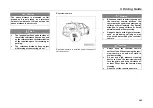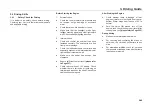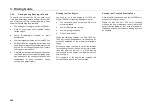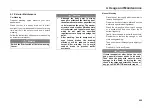
3. Driving Guide
3.6 Driving Skills
3.6.1
Safety Check for Driving
It is better to do safety check before driving.
Checking your car for a few minutes helps safe
and enjoyable driving.
Before Starting the Engine
1.
External
check
●
Check the tires for normal tire pressure and
no incision, bulge, damage or excessive
wear.
●
Check there is no tire bolts lost or loose.
●
Make sure that the headlight, brake light,
taillight, steering signal and other lights work
well. Check headlight lighting direction.
2.
Internal
check
●
Check and confirm the seat belt has been
fastened securely. The seat belts are free
from wear or damage.
●
Check the instruments and controllers, and
especially make sure the instrument indicator
lights and defroster work well.
●
Make sure the pedal has enough free
clearance.
●
Ensure sufficient coolant level
(please refer
to Page 337).
●
Check the condition of 12V battery. Check
whether there is corrosion or loosening on
terminal and cracks on the shell. Check if the
cable connection is good.
After Starting the Engine
●
Check whether there is leakage of fuel,
engine oil, water or other liquid from the car
bottom. Water drops from the use of AC is
normal.
●
Park the car on flat ground; turn off the
engine; then check the engine oil level after
the engine is cool
(please refer to Page 332).
During driving
●
Make sure the instruments work well.
●
For checking and confirming the brake on
safe road, the car shall not deviate to any
side.
●
For other abnormalities: check for no loose
components or leakage; listen whether there
is any abnormal noise.
245
















































